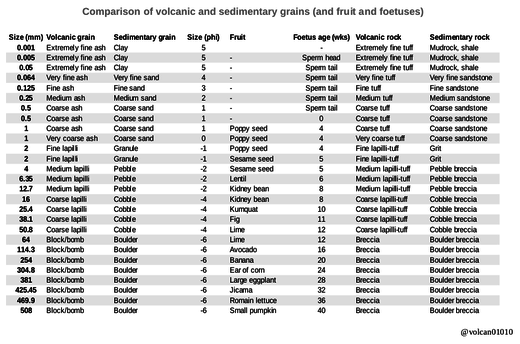volcan01010 is taking part in Paige Brown Jarreau’s #SciBlogReaders study. It aims to understand why people read science blogs. If you have a few minutes spare between now and Halloween, please take the survey. The results will help understand science blogging and to improve volcan01010. Also, you’ll get free science pictures and a chance to win a t-shirt or a $50 Amazon.com gift card! You can find the survey here: http://bit.ly/mysciblogreaders.
Volcanology has a lot of jargon. This can obscure simple information, even from trained geologists. Students are often put off by words like lapilli or tephra that sound terribly technical, even though they only mean little stones (in Latin) and ashes (in Greek). For this reason, I find it helpful to ignore the volcanology part and just treat the deposits as you would any other sedimentary rock. After all, studying explosive eruptions is just sedimentology in the atmosphere, and a volcanologist’s lapilli tuff is simply a breccia to any other geologist.
Pregnancy books are obsessed with fruit and vegetables, which are compared to the size of the growing foetus in week by week guides to development. Such comparisons are helpful to people who have never seen a ruler. They are no substitute for real numbers, though. Is a kumquat bigger than a fig? I have no idea. Nevertheless, they are fun to visualise.
For these reasons, I have compiled the following table that compares the size of volcanic particles, sediment grains, fruit and growing foetuses. I hope that it will go some way towards demystifying volcanology to sedimentologists, and gynaecology to gardeners.
Comparison of volcanic and sedimentary grains, and fruit and foetuses
Using this table, you can imagine volcanic processes in a whole new way. For example, a block and ash flow caused by a collapsing lava dome can be imagined as a hot fruit salad, containing everything from poppy seeds to (whole) pumpkins, thundering down the side of the volcano. There is also the question of the size of grains in a volcanic ash cloud; aircraft that sampled Icelandic examples them found grains about the size of sperm-heads, while the grains that are found on the ground can be two sperm long.
Further reading
- Metric babies: an old rant of mine against reporting birth weights in imperial units.
- The table includes a column for the phi scale of grainsize, which is used when data are collected by sieving sediments. Read more about it on the Wikipedia grain size page.
References
- White JDL, Houghton BF (2006) Primary volcaniclastic rocks. Geology 34:677–680. doi: 10.1130/G22346.1
- Baby sizes: http://www.babycenter.com/slideshow-baby-size?slideNumber=2#slideNumber2


